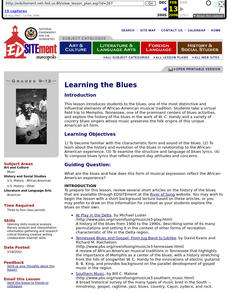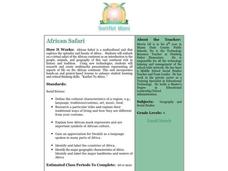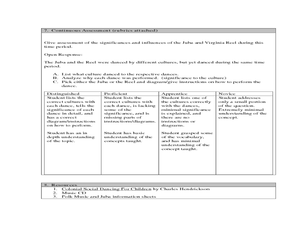Curated OER
Fossils Footprints Across Time
Students examine fossils to understand how they are formed and how they give information about geological history. In this fossil activity, students research and write about fossils and make models of different fossil types.The PDF...
Curated OER
Carnival Celebrations: Masks and Vejigantes
Young scholars explore Carnival. In this Puerto Rico Carnival lesson, students discover the history of the cultural celebration as well as the significance of the elaborate masks worn for the festivities. Young scholars create their own...
Curated OER
Master Spy
Students explain that a code is a system of symbols, letters, words, or signals that are used instead of ordinary words and numbers to send messages or to store information. They practice deciphering a variety of secret codes used in...
Curated OER
Learning the Blues
Students become familiar with the characteristic form and sound of the blues, then learn about the history and evolution of the blues in relationship to the African-American experience. Students examine the structure and language of...
Curated OER
Get On Board This Train
Students examine and discuss the African American Spiritual in a choir setting. They also sing the spiritual "Get On Board This Train" while using terms and techniques studied in the lesson plan.
Curated OER
A Guide Through the Culture of the Blues
Learners examine the history of blues music and discover how it relates to the music of today. As a class, they listen to the drum songs of Africa and compare it to the use of drums in pop music today. Using the internet, they research...
Curated OER
African Safari
Sixth graders gain an appreciation for the different cultures that inhabit the Earth by focusing on the people of Africa
Curated OER
History & Diversity
Students list the qualities needed to build strong family relationships. They gain an appreciation for the sacrifices of their ancestors who came to America and gain insights into the many fine qualities of minority families.
Curated OER
Memorable Singer 1929-1949
Young scholars examine how Louis Armstrong's fame spread from the African American community to the whole world. They examine how his singing style influenced both popular and jazz musicians by participating in guided listening of his...
Curated OER
All That is Irish and More - Activity 1
Students listen to examples of fiddle music and violin music to determine the similarities and differences between the two musical forms. A video link is included in this introductory lesson to fiddle music (Part One of Two).
Curated OER
Climate and Cultures of Africa
Young scholars gain an understanding of the relationship between climate and culture in the sub- Saharan Africa. Students will complete short exercises pertaining to the various cultures of Africa and the climate in which they live....
Curated OER
Examples of Justice Systems and Practices in Western Africa
Tenth graders explore African belief systems. In this West African lesson, 10th graders research these belief systems. Students create a wooden figure that represents these beliefs.
Curated OER
P.O.W.: Products of War
Tenth graders are introduced to concepts of war through musical lyrics. They demonstrate and understanding of the role of segregation in US military policy and practice.
Curated OER
On Stage Tonight . . .
Eleventh graders explore the World Wide Web for information concerning the period known as "The Harlem Renaissance." They study the contributions made by African Americans in the areas of literature, art, and music during this period in...
Curated OER
Humanities in Colonial and Revolutionary America
Learners demonstrate dances of colonial America. In this colonial American lesson, students learn forms of colonial social dancing including the Juba and Virginia Reel. Learners examine the history of the 2 dances as well.
Curated OER
Dinosaurs Were Real!
Students investigate the history of dinosaurs, as real animals. In this dinosaur lesson plan, students examine basic concepts that help them understand the history of all life. Included in this article is information on the world of the...
Curated OER
Learning from Letters and Other Mail
Students explore the history of our mail system. In this postal lesson plan, students evaluate mail as a means of communication, create a mail system in their classroom where they can send and receive mail. Once the students receive...
Curated OER
Paper Vests
Second graders listen to background information on designated Black Americans and read some books about them. They choose one of the persons studied and create a paper vest relating the person's contributions.
Curated OER
Harriet Tubman and The Underground Railroad
First graders discuss Black History month and read a book about The Underground Railroad. For this history lesson, 1st graders discuss and answer questions as the book is read, and complete a worksheet about their feelings and reactions...
Curated OER
Facial Tattoos or Face Painting
Students use a grid-like method to create a life-size self-portrait from a 3X5 black and white photo. They explore the different customs and rituals surrounding face painting from ancient through modern civilizations. Students create a...
Curated OER
World War II: "The Other" Americans
Eleventh graders examine the roles of women and minorities during Word War II. In this American History instructional activity, 11th graders watch the video "Saving Private Ryan". Students read a book on the topic and answer...
Curated OER
Exploring Cultural Rituals
Students analyze images and music of common rituals in America with those of other countries. They use worksheets to compare and contrast the events.
Curated OER
The Story of Kwanzaa
Celebrate Kwanzaa with a game of Kalah, also known as Mankala or Owara. Using an egg carton and a set of beans, players take all of the beans out of one of his or her cups and move to the right, dropping one bean into each of the next...
Curated OER
Letters from the Japanese American Internment
Students examine letters of Japanese-American children during internment in World War II. They discover what it was like in the camps and how they were treated once they were released. They also view photographs of the camps.

























